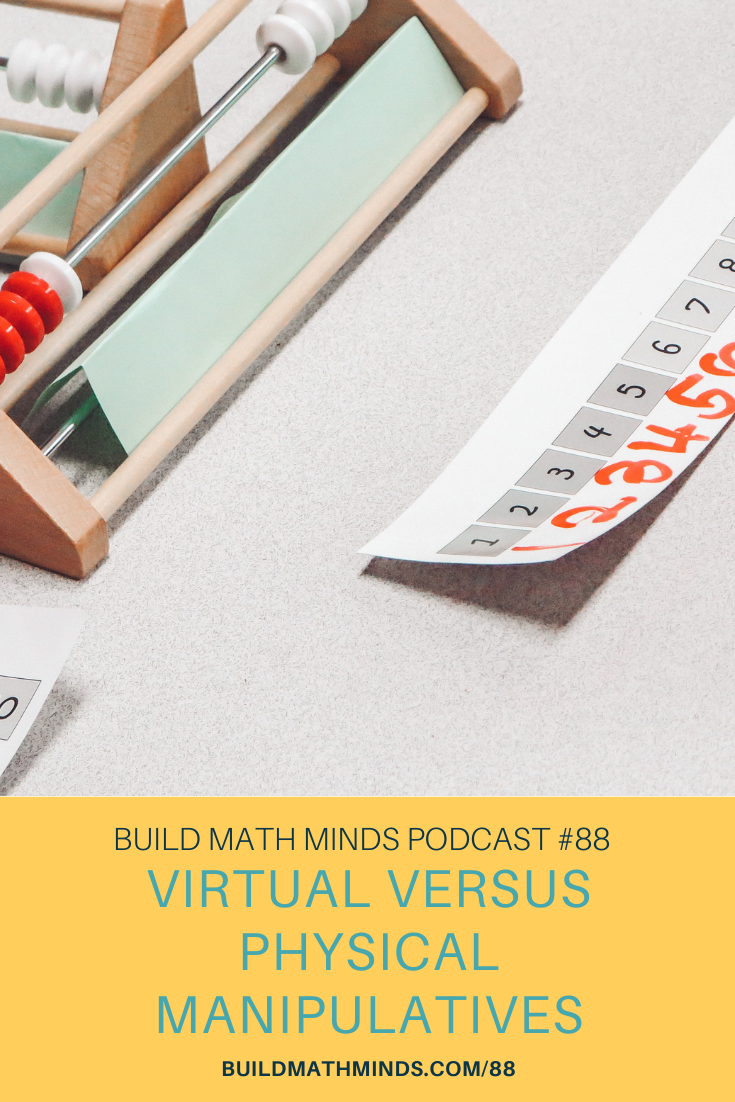Resources mentioned in this episode:
Physical and Virtual Manipulatives: What Is “Concrete”? By Julie Sarama and Douglas H. Clements (Chapter 4 in International Perspectives on Teaching and Learning Mathematics with Virtual Manipulatives (pp.71-93))
C-R-A Approach video training
The Math Learning Center Apps (virtual manipulatives)
BrainingCamp (virtual manipulatives)
Become a member of the Build Math Minds PD site
Welcome fellow Recovering Traditionalists to Episode 88. Today we are looking at Virtual versus Physical Manipulatives.
With distance learning happening for so many right now, during a Build Math Minds Members Q & A session, a member asked if it’s okay to just have kids working with virtual manipulatives or if kids need the physical manipulatives to ensure they are working in the Concrete level.
As I went digging into the research, I found that this is not a new concern. In 2016, Julie Sarama & Douglas Clements wrote a chapter in the book International Perspectives on Teaching and Learning Mathematics with Virtual Manipulatives that can shed some light on this concern that educators are having in 2021.
As I read the quote from the book, I’m going to leave out all the references to the research Sarama & Clements are drawing their claims from. Mainly because there are so many that it is hard to read the content and the references and still get the meaning of the research shared. So to see all the references for this information.
On page 73, they write:
“In a similar vein, it is not just symbols that are too often learned by rote. Students often learn to use manipulatives by rote (Miura and Okamoto 2003). They perform the correct steps but have learned little more about the manipulation of quantities. One student used beans and beansticks to model place value, but used the (one) bean as ten and the beanstick (with ten beans on it) as one (Hiebert and Wearne 1992). In a similar study, kindergarten students could not use simple cubes to help them solve simple addition and subtraction problems. They did not have a strategy to use the cubes to solve the problems. Using a number line was even more difficult (Skoumpourdi 2010). These and other studies support an essential point: Although they provide support and mediation, manipulatives do not ‘carry’ mathematical ideas directly to the learner. ‘Although kinesthetic experience can enhance perception and thinking, understanding does not travel through the fingertips and up the arm’ (Ball 1992, p. 47).”
So what they start off the chapter explaining is that it is more about how we use the manipulatives as a part of our instruction, than if the manipulatives are virtual or physical.
When we help kids see the connection between all three models (Concrete, Representation, and Abstract) we help them build their math minds and not just teach them to follow steps and procedures with a layer of manipulatives added in.
Instead we should do what I call the Sweet Spot of the C-R-A approach. That’s when kids do Concrete, Representation, and Abstract together to help them build the connections between them. I’ll link to a video training I’ve done that will give you more information about all three and why it’s so important to build the connections between them.
On page 74, Sarama & Clements do reference research that says using virtual manipulatives isn’t bad for students, in fact it might actually be better. There were many reasons why but I found this one to be particularly interesting:
“Qualitative evidence indicated that the virtual manipulatives helped students because they were easier and faster to use and because they provided immediate and specific feedback.”
That is an excellent PRO for virtual manipulatives. Often when kids are using physical manipulatives, we aren’t right there beside each child to help them along the way. But the way some virtual manipulatives are set up, gives students that feedback instantly that they don’t get when using physical manipulatives.
So to sum it up, it doesn’t matter if you use physical or virtual manipulatives. Whichever you use (maybe even both), just make sure you help build the connections between the Concrete, Representation, and Abstract.
They go on throughout the chapter detailing what is truly meant for something to be ‘concrete’ in math along with different levels of concrete-ness, and so as always, I encourage you to go read the chapter for yourself. It is available to be read online for free.
Subscribe and Review in iTunes
Hey, are you subscribed to the Build Math Minds Podcast, yet? If you’re not, make sure to do that today because I don’t want you to miss any episodes! Click here to subscribe to the podcast in iTunes.
While you’re there, don’t forget to leave a review on iTunes too. I would love to know your thoughts and how we can make sure that we give you content that you will really enjoy.
To leave a review, head over to iTunes and click on “Ratings and Reviews” and “Write a Review.” I can’t wait to hear your thoughts about the podcast.




